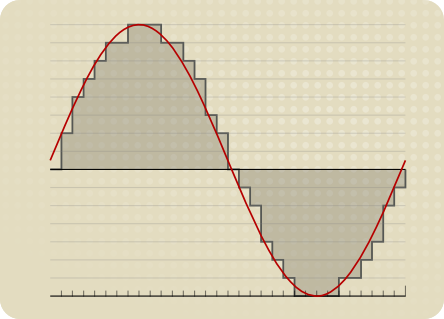1.3. Sample, Sample Rate, Sample Format, and Bit Rate
The primary function of audio interfaces is to convert signals between analog and digital formats. As mentioned earlier, real sound has an infinite possibility of pitches, volumes, and durations. Computers cannot process infinite information, so the audio signal must be converted before they can use it.
The diagram in
Figure 1.1, “A waveform approximated by computer” illustrates the situation. The red wave shape represents a sound wave that could be produced by a singer or an acoustic instrument. The gradual change of the red wave cannot be processed by a computer, which must use an approximation, represented by the gray, shaded area of the diagram. This diagram is an exaggerated example, and it does not represent a real recording.
The conversion between analog and digital signals distinguishes low-quality and high-quality audio interfaces. The sample rate and sample format control the amount of audio information that is stored by the computer. The greater the amount of information stored, the better the audio interface can approximate the original signal from the microphone. The possible sample rates and sample formats only partially determine the quality of the sound captured or produced by an audio interface. For example, an audio interface integrated into a motherboard may be capable of a 24-bit sample format and 192 kHz sample rate, but a professional-level, FireWire-connected audio interface capable of a 16-bit sample format and 44.1 kHz sample rate may sound better.
A sample is a unit of audio data. Computers store video data as a series of still images (each called a "frame"), and displays them one after the other, changing at a pre-determined rate (called the "frame rate"). Computers store audio data as a series of still sound images (each called a "sample"), and plays them one after the other, changing at a pre-determined rated (called the "sample rate").
The frame format and frame rate used to store video data do not vary much. The sample format and sample rate used to store audio data vary widely.


